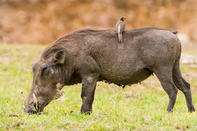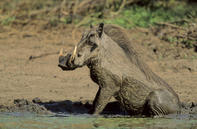Look Bigger
Warthogs are mostly hairless but what hair they do have serves vital functions. The mane of long, rough hair along their backs is erected, called pilo-erection, when they are stressed. This probably serves to make the small animal look more intimidating to opponents or predators.

The pronounced cheek whiskers particularly present in juveniles are a clever form of mimicry. The white hair imitates the adults’ fearsome tusks while they are still developing in the youngsters and serves to deter would-be predators even though the piglets are essentially defenceless.
Because warthogs have typically hairless bodies, they make regular use of mud-wallows to help regulate their body temperature on hot days. The thermoregulatory ‘bath’ also aids in parasite removal and warthogs are prone to rubbing themselves on any convenient post to remove caked mud and concurrently the encrusted ticks. Warthogs are further aided in parasite-removal by red-billed oxpeckers.
They are the smallest ungulates attended to by these useful birds who frequently warn them of danger. Warthogs rely on and respond to these and other animals’ alarm calls as they are both short-sighted and short-legged!
Burrows to Order

Without much subcutaneous fat, piglets are especially sensitive to cold and wet conditions and up to 50% of warthog young die in their first six weeks due to sudden temperature fluctuations, and predation.
To help overcome these risks, warthog sows excavate their burrows with an internal shelf that serves as a ‘bunk-bed’ to keep the young off the floor in the event of flooding. If the shelf is absent from a particular burrow, the piglets will sleep on the sow’s back. Using their forefeet, warthogs adjust holes to their own specifications moving the loosened dirt with their shovel-shaped snouts.
They prefer to use large burrows that have numerous entrances as this offers more escape options should a predator try to dig them out. For this reason, as well, warthogs usually reverse into their burrows so that their weapon-like tusks are facing any potential danger.
They are very careful when leaving their burrows hesitating to listen for danger first but less cautious about entering holes which they may have to bolt into to escape a threat! The juveniles typically pile in first while the adult turns around at the last minute to reverse and thereby creates a cloud of distracting dust.
A sounder of warthog may use up to 10 holes alternately within their home range and neighbouring sounders may even share homes on a first-come-first-serve basis.
By Megan Emmett